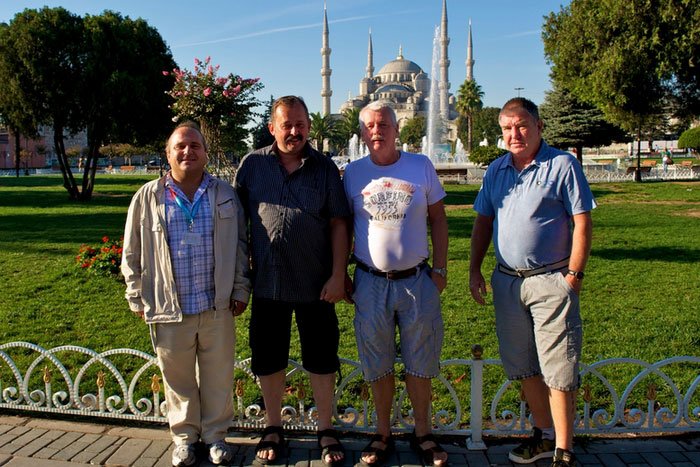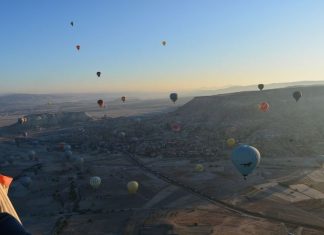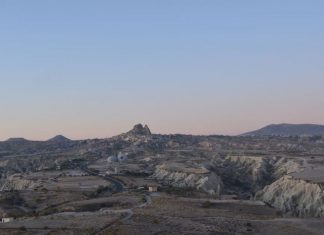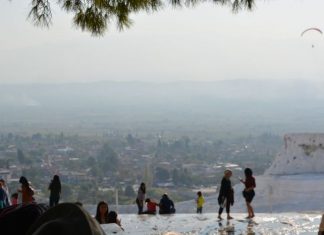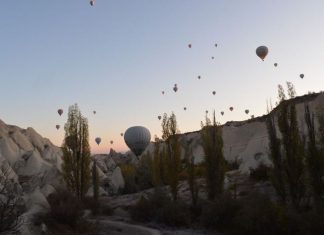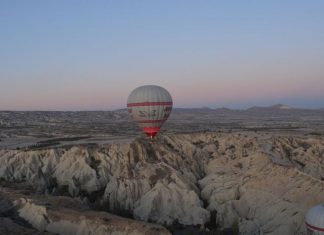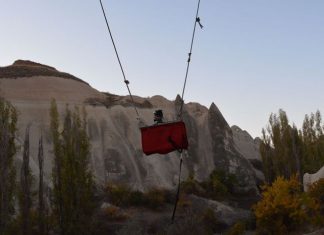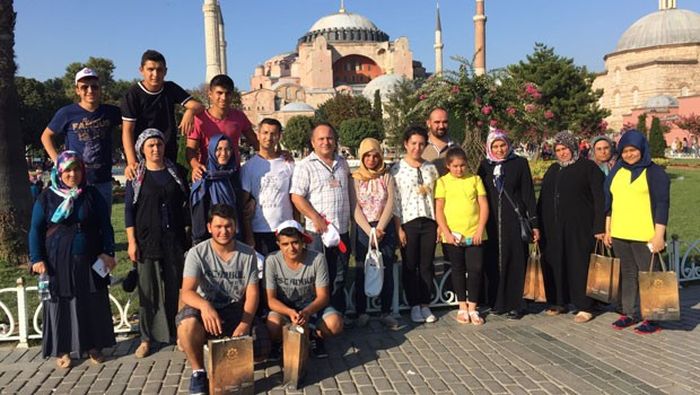The Magic of the Bosphorus
Necati Güngör’s compiled work, “Boğazın Büyüsü,” provides a literary perspective on the Bosphorus, allowing us to draw comparisons between its past and present.
The Bosphorus stands as a symbol of Istanbul, and exploring its history through the lens of literary figures adds a unique pleasure to the experience. Journalist and storyteller Necati Güngör, in his book “Boğazın Büyüsü,” gathers writings from literary figures, with a focus on the renowned traveler Evliya Çelebi, offering insights into the Bosphorus. Published by İnkılap Publications, “Boğazın Büyüsü” allows us to juxtapose the Bosphorus of the past, including its people, quays, religious communities, economy, and ethnic groups, with its current state. The book also reveals the gaps in our knowledge and memory concerning the Bosphorus, prompting a sense of shame The First Church Dedicated to Virgin Ma
The First Church Dedicated to Virgin Mary
The First Church Dedicated to Virgin Mary and the World’s First Advertisement Hoard
The Double Churches, also known as the Consul Church, hold a distinctive position in the Christian world as the first church constructed in honor of Virgin Mary. Originally a place for consul meetings in the 5th century AD, the church underwent transformation into a basilica during the Roman era, eventually becoming dedicated to Virgin Mary. It was during a meeting of the third consul convened here that the decision to establish “Catholicism” was made, making the edifice significant as one of the seven churches of Christianity.
The appellation “Double Churches” emerged with the addition of a second church in the 7th century AD. Ephesus, at the time, boasted advanced infrastructure, including heating, water, and sewage systems. The city’s primary sewage system passed beneath a marble-covered street, featuring columns several meters high and cast lead
Tour guide Ensar
Brusa’s Natural Beauty and Cultural Gems
Mount Olympus (Keshish Dagh)
Mount Olympus, known as Keshish Dagh (Mount Monk) in Turkish, stands at 7600 feet above sea level. For a successful ascent, a good guide and a few soldiers, arranged through the Consul, are essential. The journey takes about six hours, with the last part on foot due to steep terrain. The descent typically takes four hours. Travelers need to bring provisions from Brusa, as there are no amenities along the way. Costs include horse fare (50 piastres), guide fee (20 piastres), and soldiers’ fees (20 piastres each). The summit provides a splendid panoramic view on clear days, encompassing the Marmora and Bosporus, Mount Ida, the plains of Troy, Mysia, Phrygia, and Pergamo and Kutahieh.
Return trains to Mudania depart from Brusa around 7:30 A.M. Exploring Brusa’s Landmarks and Industries, connecting to the steamer to Constantinople, where travelers disembark at Galata pier.
Exploring Brusa’s Landmarks and Industries
The Mosque of Murad I.
Located on Chekirieh Hill just outside Brusa, near the Medicinal Hot Springs and Baths, the Mosque of Murad I is a prominent structure. Opposite stands the Mausoleum of Murad I, also known as Ghazl Hudavendighiar (‘Conquering Sovereign’). The mausoleum displays Murad’s blood-stained breastplate Mausoleums of Brusa, turbans, and other relics. A bronze bowl near the tomb holds blessed corn for distribution to the local people.
The ablutionary fountain near Murad’s tomb features mineral water, with some nearby springs being hot. The terrace offers a splendid view of the mountains and Ulfer Chaee valley, where visitors can enjoy chairs and coffee from a nearby coffee-house.
Silk Factories
Brusa’s Silk Factories are a worthwhile visit, with courteous proprietors willing to guide visitors. The Manufacture Brotte, located behind the Hotel d’Anatolie, houses the largest and
Mausoleums of Brusa
History and Artistry
The Mausoleum of Orkhan
Situated to the right upon entering the esplanade, the Mausoleum of Orkhan houses the tomb of his elder brother, Allah-ed-Din, along with those of several princes and princesses. Entrance fee: 5 piastres per party.
Muradieh Quarter
Adjacent to the Mosque of Murad II, the Muradieh quarter hosts various mausoleums dedicated to sultans and princes. Artists and enthusiasts should explore this area. The most intriguing is the Mausoleum of Murad II, unique as a sultan’s final resting place. Murad II desired simplicity Brusa’s Natural Beauty and Cultural Gems, evident in the plain grass-planted mound edged with marble. The dome, intentionally pierced, allows rain and snow to fall on it, fulfilling Murad II’s wish for exposure to the weather like that of a common man. Two turbans worn by Murad II are displayed, including one for Fridays and ano
Clothing and Accessories
Preserving Centuries of Style
Delving into the roots of Ottoman clothing culture, curator Mr. Esat Uluumay highlights the rich history embedded in dresses dating back to as much as 200 years. Despite the challenges of transportation and communication, these garments visually transport us to an era nearly 600 years ago, showcasing minimal changes in accessories, fabrics, and sewing techniques.
Adorning Every Detail
Uluumay Museum’s comprehensive collection goes beyond mere clothing, showcasing a vast array of accessories—from headgear to shoes, guns to socks—meticulously arranged based on the distinctive styles of each region Journey of Ottoman Clothing and Accessories. Human history reflects a consistent desire for embellishment and decoration, evident in the varied usage of accessories driven by the instinct to possess valuable items, seek admiration, avert natural disasters, ward off the
Journey of Ottoman Clothing and Accessories
Preserving Cultural Narratives
Clothing and accessories, witnesses to humanity’s evolving journey over centuries, unfold the tales of bygone eras. Serving as a visual narrative of the past, they provide a captivating story for future generations.
Pioneering the First Dress Museum in Turkey
The Uluumay Museum of Clothes and Accessories of the Ottoman People, Turkey’s inaugural dress museum, showcases samples of Turkish culture spanning from Central Asia to Anatolia. The curator, Mr. Esat Uluumay A Glimpse into Anatolia’s Hidden Gem, sheds light on the museum’s inception and purpose.
Inception and Inspiration
Mr. Esat Uluumay, inspired by his extensive travels with the Sword and Shield Folk Dance group, noticed the impact of modernization on local clothing during contests across Turkey. Observing the inadequacy of existing resources in portraying the authenticity of clo
A Glimpse into Anatolia’s Hidden Gem
Exploring the Enigmatic Metropolis
Perge boasts not only houses but also a one-of-a-kind Metropolis, unparalleled in Anatolia. A significant challenge remains unresolved: despite falling within the boundaries of a first-degree archaeological site, this area remains privately owned and undisclosed. Urgent action is needed to make this extraordinary site publicly accessible.
Diverse Tombs Tell Tales
Within this archaeological marvel, diverse tombs narrate unique stories. Ranging from podium tombs to those crafted from local stones, marble sourced from Afyon province Clothing and Accessories, engraved rock tombs, and brick-built tombs, a striking feature is the presence of magnificent mausoleums. These two-story structures house well-preserved compartments in the lower level, each containing a tomb. Additional, simpler tombs in the front courtyard of the burial chamber have revealed 18 skeletons in one and four in the ot
Traditional Wedding Horse Ride and Celebration
In this village, the wedding celebrations continue as the father and uncle escort the bride to where the horse awaits. Once the bride mounts the horse, they head to the groom’s home. A customary route takes them around the mosque, and tourists can join the bride’s group if interested. Upon arriving at the groom’s home, they inquire about the groom’s whereabouts. After a brief wait, the groom arrives, passing under the horse’s neck to symbolize unity. Coins and wheat are thrown over the bride’s head, and the groom embraces her, marking the start of the festivities.
Festive Entertainment and Local Cuisine
The celebration kicks off with a dance between the bride and groom in the center. Local dishes, including keşkek, sarma, pilaf, otlubörek, helva Gift Presentation Ceremony at the Engagement, and salad, are served on copper plates and trays. The drink options range from t


